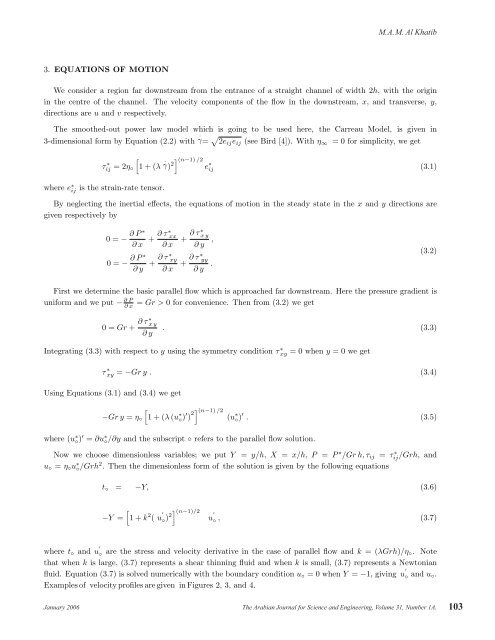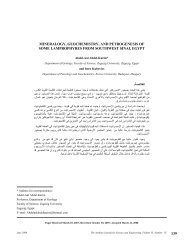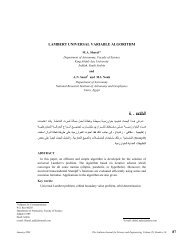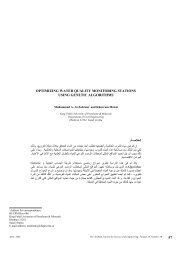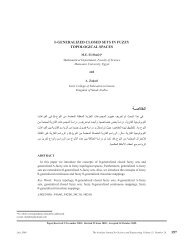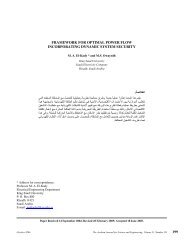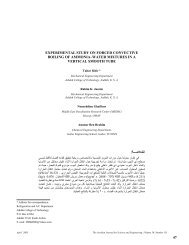the development of poiseuille flow of a pseudoplastic fluid
the development of poiseuille flow of a pseudoplastic fluid
the development of poiseuille flow of a pseudoplastic fluid
You also want an ePaper? Increase the reach of your titles
YUMPU automatically turns print PDFs into web optimized ePapers that Google loves.
3. EQUATIONS OF MOTION<br />
M.A.M. Al Khatib<br />
We consider a region far downstream from <strong>the</strong> entrance <strong>of</strong> a straight channel <strong>of</strong> width 2h, with <strong>the</strong> origin<br />
in <strong>the</strong> centre <strong>of</strong> <strong>the</strong> channel. The velocity components <strong>of</strong> <strong>the</strong> <strong>flow</strong> in <strong>the</strong> downstream, x, and transverse, y,<br />
directions are u and v respectively.<br />
The smoo<strong>the</strong>d-out power law model which is going to be used here, <strong>the</strong> Carreau Model, is given in<br />
3-dimensional form by Equation (2.2) with · γ= 2eijeij (see Bird [4]). With η∞ = 0 for simplicity, we get<br />
where e ∗ ij<br />
τ ∗ ij =2η◦<br />
is <strong>the</strong> strain-rate tensor.<br />
<br />
1+(λ · γ) 2(n−1) /2<br />
e ∗ ij<br />
By neglecting <strong>the</strong> inertial effects, <strong>the</strong> equations <strong>of</strong> motion in <strong>the</strong> steady state in <strong>the</strong> x and y directions are<br />
given respectively by<br />
0=− ∂P∗<br />
∂x + ∂τ∗ xx<br />
∂x + ∂τ∗ xy<br />
∂y ,<br />
0=− ∂P∗<br />
∂y + ∂τ∗ xy<br />
∂x + ∂τ∗ yy<br />
∂y .<br />
First we determine <strong>the</strong> basic parallel <strong>flow</strong> which is approached far downstream. Here <strong>the</strong> pressure gradient is<br />
uniform and we put − ∂P<br />
∂x = Gr > 0 for convenience. Then from (3.2) we get<br />
0=Gr + ∂τ∗ xy<br />
∂y<br />
January 2006 The Arabian Journal for Science and Engineering, Volume 31, Number 1A. 103<br />
(3.1)<br />
(3.2)<br />
. (3.3)<br />
Integrating (3.3) with respect to y using <strong>the</strong> symmetry condition τ ∗ xy = 0 when y =0weget<br />
τ ∗ xy = −Gr y . (3.4)<br />
Using Equations (3.1) and (3.4) we get<br />
−Gr y = η◦<br />
<br />
1+(λ (u ∗ ◦) ′ ) 2 (n−1) /2<br />
where (u ∗ ◦) ′ = ∂u ∗ ◦/∂y and <strong>the</strong> subscript ◦ refers to <strong>the</strong> parallel <strong>flow</strong> solution.<br />
(u ∗ ◦) ′ . (3.5)<br />
Now we choose dimensionless variables; we put Y = y/h, X = x/h, P = P ⋆ /Gr h, τij = τ ∗ ij /Grh, and<br />
u◦ = η◦u∗ ◦/Grh2 . Then <strong>the</strong> dimensionless form <strong>of</strong> <strong>the</strong> solution is given by <strong>the</strong> following equations<br />
t◦ = −Y, (3.6)<br />
−Y =<br />
<br />
1+k 2 ( u ′<br />
◦) 2 (n−1)/2<br />
u ′<br />
◦ , (3.7)<br />
where t◦ and u ′<br />
◦ are <strong>the</strong> stress and velocity derivative in <strong>the</strong> case <strong>of</strong> parallel <strong>flow</strong> and k =(λGrh)/η◦. Note<br />
that when k is large, (3.7) represents a shear thinning <strong>fluid</strong> and when k is small, (3.7) represents a Newtonian<br />
<strong>fluid</strong>. Equation (3.7) is solved numerically with <strong>the</strong> boundary condition u◦ = 0 when Y = −1, giving u ′<br />
◦ and u◦.<br />
Examples <strong>of</strong> velocity pr<strong>of</strong>iles are given in Figures 2, 3, and 4.


